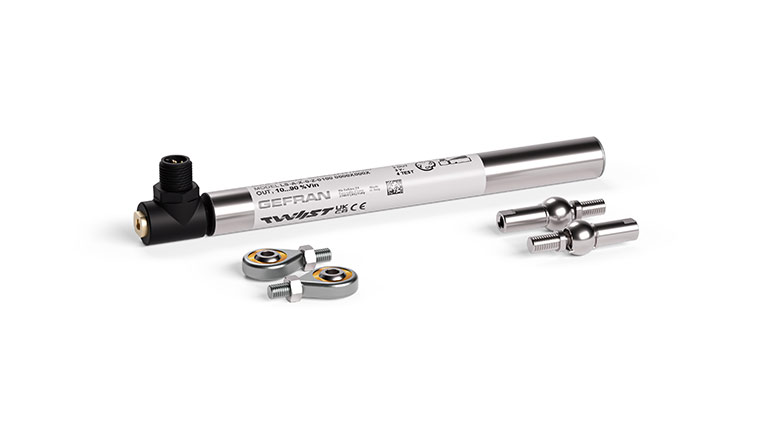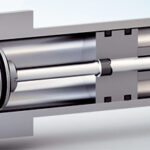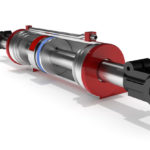After 10 years of research, Gefran, an Italian sensor and control company, has launched its Twiist contactless linear position transducer to the North American market. The transducer not only measures position but can also measure temperature, velocity, acceleration, and tilt angle.
“There are several products on the market that measure position and Gefran has them as well, but only Twiist can measure position, acceleration, speed, vibration, and three spatial angles (x, y, and z axes) all at the same time,” said Edoardo Zilioli, Gefran’s Marketing Manager, Sensors Division. “And if desired, Twiist can also monitor the ambient temperature inside the transducer. Readings and data processing happen simultaneously.”

This multi-variable position transducer is in the Hall effect category, but what truly sets it apart is its unique helical magnetoelectronic design, its ability to take multiple measurements simultaneously, and its focus on improving operator safety. This patented technology is the result of a decade-long partnership between Gefran’s internal R&D department and the University of Brescia’s engineering department in Brescia, Italy.
“Gefran offers a complete bundle of electrical products — sensors, controls, instrumentation, etc. — for industrial machinery, but the Twiist is perfect for mobile and industrial hydraulic applications,” said Ron Akers, Gefran’s Business Development Manager for fluid power. “It allows for multiple types of measurement in one component. Signals for linear and angular positioning and temperature readings are all communicated at the same time. Furthermore, with the onboard electronics, Twiist provides real-time velocity, acceleration, and tilt angle measurements to keep operators safer.”
The compact design is not limited to 250 mm stroke ranges like traditional Hall effect sensors, said Zilioli. “Measuring linear displacement with a Hall effect chip encapsulated by a magnetic helix is an innovative and ingenious idea. It revolutionizes the classic Hall effect sensor in the range of 5 mm, which among other things is limited to strokes of up to 250 mm,” Zilioli said. “Not only does Twiist reduce the number of expensive components needed for a project, but it is a redundant position transducer with a more useful electrical stroke of 50 to 900 mm.”
Twiist’s compact, air-tight design has a steel barrel with a diameter of 5/8 in. (16 mm) and it comes with a choice of two types of connection points, ball joints for swivel connections and rod ends with eyes for pivot connections. Available in full-scale (FS) strokes from 50 to 900 mm, it has typical linearity of 0.15% FS and typical repeatability of 0.05% FS. It can operate in a temperature range from -40°F to 185°F (-40°C to 85°C).
The Twiist has an IP67 environmental protection rating as well, offering complete protection against dust and airborne particles, as well as protection against water and other liquids when submerged up to 39 in. (1 m) deep. This resistance to contamination makes it ideal for fluid power applications and extends the life of the part and equipment.
Applications could include many in mobile hydraulics. For example, when steering a vehicle, while using spatial inclination and acceleration, the Twiist verifies, at each millisecond, if the ground is stable underneath the construction equipment and it can alert the operator if there is a danger of unstable ground, Zilioli noted. All of this is directly on the steering axis, without any mechanical interference, or worse, mechanical play.
Other applications include: control of stabilization footings in area platforms (extension and subsidence), monitoring position and vibration for mining, fracking, and drilling, and measuring position and inclination for phytochemical sprayer arms on agricultural sprayers. Practically all medium-complex vehicles could use a Twiist multivariable transducer, Zilioli said.

Available outputs are both analog and digital. With the CANopen fieldbus and IO-Link output capabilities, measurements related to process variables, such as position, speed, and inclination are digitally transmitted up to 1,000 times per second. With its integrated CPU, the Twiist collects and analyzes operational data and provides a feedback loop to ensure equipment performance is optimized and operators are kept safe. These magnetoelectronic signals can also monitor process information related to vibration peaks, hours of operation, distance traveled, and more.
To measure inclination signals with high accuracy (three axes: x, y, and z), Gefran uses MEMS chips and proprietary algorithms that are both sophisticated and immune to micro-vibrations. Gefran has successfully used this technology since 2015 in many of its products and customers use it in applications from mobile hydraulics (mining vehicles, mobile aerial work platforms, etc.) to geotechnics in civil engineering (checking for rocks and soil make-up to plan for tunnels, bridges, reservoirs, etc.).
Zilioli noted that the biggest challenge developing one component to measure multiple data points was the need to make a metrologically accurate sensor. It had to be manufactured with high-quality materials, be well protected from the environment, be compact in size, and provide consistent and reliable results.
“Gefran has an R&D department that is enviable, and we invest heavily in research through an ever-increasing headcount, annual financial investments, and academic partnerships,” Zilioli said. “Gefran is also a multi-project and multi-entity company, and for as long as I can remember (since 1968 actually), we’ve operated with agility in terms of projects and operations. For example, in one year alone, I worked on a position sensor, next a wireless force transducer, and then an ultra-compact, Lilliputian pressure transducer. In practice, this kind of flexibility and versatility is part of Gefran’s DNA, and to be honest, we enjoy solving complicated problems.”
Zilioli added that accuracy was a challenge within a challenge. “Already a small transducer with a 16-mm diameter housing and a 5 mm wide by 900 mm long internal electronic circuit, the Twiist was a unique enterprise,” he said. “While evaluating strategic redundancy, we knew there were only a couple of suppliers who would make a small multi-layer circuit board. We knew it was a great opportunity and after years of research, we arrived at the final design.
“Gefran has another hidden and little-known talent. We own and operate several surface-mounting technology (SMD) machines and we use them for assembling our chips and electronic components,” Zilioli concluded. “Gefran does not rely on external suppliers to do this work, so we can control production and maintain the quality of our products.”
Controllers can reduce the number of line items on their bill of materials, thus reducing the number of parts needed as well as lower costs for purchasing. With fewer failure points due to the reduction of parts and the robustness of the Twiist’s design, engineers and warranty departments benefit alike. For the end user, Twiist offers a simplified proportional system that is easier to use and maintain. Furthermore, in keeping up with the changing pace of technology, if new firmware features and enhancements enter the market, Gefran will provide version updates that can be made onsite.
“The future for TWIIST is wide open. As we partner with more engineers and industrial designers, they will think of new ways to apply TWIIST technology to their own products,” said Tapan Mody, General Manager at Gefran. “This is an innovative and exciting product.”
The analog version of the rod-shaped Twiist sensor is characterized by an extremely low parameterization effort. It offers a direct standard signal and allows contactless measurement at a very low cost. Additional amplifiers, such as those required for potentiometric transducers, are completely unnecessary. This advantage is used by a Gefran customer who uses the new displacement transducer to control the hydraulics at the outlet flap of his concrete mixer. The concrete flow from the mixer into the transport vehicle is controlled via the opening of the flap. In the case of very dry concrete, which behaves like granular sand, the flap can be opened completely. Moist, rather liquid concrete, on the other hand, would burst uncontrollably out of the mixer if the outlet flap were completely open and end up anywhere but in the tank wagon. For a controlled flow into the vehicle, the flap must therefore only be opened very slowly and partially.
The position sensor originally mounted on the hydraulic cylinder had to be replaced every four to six months. When the concrete mixer was flushed out with water, the concrete-water mixture attacked the seal between the push rod and the guide tube over time. This allowed water to penetrate the sensor and destroy the measuring element. For the Twiiist sensor, which has IP67 protection as standard, penetrating water is no problem. Its Hall chip measuring element sits in a hermetically sealed square steel tube that is moved back and forth by the helical magnetic field applied to the outer steel tube (diameter of 16 mm) with the help of a sliding bush. The cleaning fluid can therefore penetrate the space between the square tube and the outer tube, but does not cause any damage. This also benefits the operator of the concrete plant, for whom the time-consuming and cost-intensive sensor changes are no longer necessary.
In addition to the analog version of the compact, rod-shaped displacement transducer (model LS-A), a redundant ratiometric version is available to support safety applications, as well as variants with CANopen (model LM-C) or IO-Link (model LM-L). The sensor models with digital interfaces not only facilitate integration into the respective machine and control architectures. They also allow the acquisition and transmission of additional process variables at a transmission rate of up to 1,000 times per second. The acyclic information that the digital sensors process and make available includes the kilometers traveled by the cursor, i.e. how often the push rod has moved back and forth, the maximum temperature reached, and working hours.
All the collected data is analyzed by an integrated powerful CPU and put into relation to each other. This allows the sensor — depending on the specific customer applications — to realize functions for self-diagnosis, self-correction, and recognition of machine and process behavior, including predictive (remote) maintenance down to the sensor level.
Gefran
gefran.com






